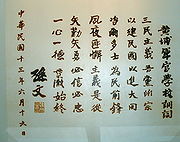| Revision as of 14:34, 25 January 2015 editBeefball (talk | contribs)417 editsm →Lyrics: fix linkTag: Visual edit← Previous edit | Revision as of 03:41, 27 March 2015 edit undo76.167.232.59 (talk) →LyricsNext edit → | ||
| Line 65: | Line 65: | ||
| 一心一德,貫徹始終。</poem> | 一心一德,貫徹始終。</poem> | ||
| |<poem lang="zh-hans" style="font-size:125%"> | |<poem lang="zh-hans" style="font-size:125%"> | ||
| 三民主义,吾党所宗; | |||
| 以建民国,以进大同。 | |||
| 咨尔多士,为民前锋; | |||
| 夙夜匪懈,主义是从。 | |||
| 矢勤矢勇,必信必忠; | |||
| 一心一德,贯彻始终。</poem> | |||
| |} | |||
| {| cellpadding=3 | {| cellpadding=3 | ||
Revision as of 03:41, 27 March 2015
| This article needs additional citations for verification. Please help improve this article by adding citations to reliable sources. Unsourced material may be challenged and removed. Find sources: "National Anthem of the Republic of China" – news · newspapers · books · scholar · JSTOR (November 2008) (Learn how and when to remove this message) |
Template:Contains Chinese text
| English: National Anthem of the Republic of China | |
|---|---|
| 中華民國國歌 | |
 Manuscript of the speech at the opening ceremony of the Whampoa Military Academy in Dr. Sun Yat-sen's hand. Manuscript of the speech at the opening ceremony of the Whampoa Military Academy in Dr. Sun Yat-sen's hand. | |
National anthem of | |
| Also known as | San Min Chu-i (English: Three Principles of the People) |
| Lyrics | From a speech by Sun Yat-sen, 1924 |
| Music | Cheng Maoyun, 1928 |
| Adopted | 1937 (de facto) 1943 (de jure) |
| Audio sample | |
| National Anthem of the Republic of China | |||||||||||||||||||||||||
|---|---|---|---|---|---|---|---|---|---|---|---|---|---|---|---|---|---|---|---|---|---|---|---|---|---|
| Traditional Chinese | 中華民國國歌 | ||||||||||||||||||||||||
| Simplified Chinese | 中华民国国歌 | ||||||||||||||||||||||||
| |||||||||||||||||||||||||
The national anthem of the Republic of China (Chinese: 中華民國國歌; pinyin: Zhōnghuá Mínguó guógē) speaks how the vision and hopes of a new nation and its people can and should be achieved and maintained using the Three Principles of the People. Originally the party anthem of the ruling Kuomintang, it was officially adopted as the national anthem in 1943 during the Second World War. Informally, the song is sometimes known as "San Min Chu-i" or "Three Principles of the People" from its opening line, but this is never used in formal or official occasions.
History
The text of was the collaboration between several Kuomintang (KMT) party members,
- Hu Han-min (胡漢民 Hú Hànmín),
- Tai Chi-t'ao (戴季陶; Dài Jìtáo),
- Liao Chung-k'ai (廖仲愷 Liáo Zhòngkǎi)
- Shao Yüan-ch'ung (邵元沖 Shào Yuánchōng).
The text debuted on July 16, 1924 as the opening of a speech by Sun Yat-sen at the opening ceremony of the Whampoa Military Academy.
After the success of the Northern Expedition, the Kuomintang party chose the text to be its party anthem and publicly solicited for accompanying music. Ch'eng Mao-yün (程懋筠; Chéng Màoyún) won in a contest of 139 participants.
On March 24, 1930, numerous Kuomintang party members proposed to use the speech by Sun as the lyrics to the national anthem. The national anthem of the republic was the Song to the Auspicious Cloud. Due to opposition over using a symbol of a political party to represent the entire nation, the National Anthem Editing and Research Committee (國歌編製研究委員會) was set up, which endorsed the KMT party song. On June 3, 1937, the Central Standing Committee (中央常務委員會) approved the proposal, and in 1943, the song officially became the national anthem of the Republic of China.
Lyrics

| Traditional Chinese | Simplified Chinese | |||||||||||||||||||||||||||||||||||||||||||||||||||||||||
|---|---|---|---|---|---|---|---|---|---|---|---|---|---|---|---|---|---|---|---|---|---|---|---|---|---|---|---|---|---|---|---|---|---|---|---|---|---|---|---|---|---|---|---|---|---|---|---|---|---|---|---|---|---|---|---|---|---|---|
|
三民主義,吾黨所宗; |
<poem lang="zh-hans" style="font-size:125%">
The lyrics are in classical literary Chinese. For example,
In this respect, the national anthem of the Republic of China stands in contrast to the People's Republic of China's "The March of the Volunteers", which was written a few years later entirely in modern vernacular Chinese. As well as being written in classical Chinese, the national anthem follows classical poetic conventions. The style follows that of a four-character poem (四言詩), also called a four-character rhymed prose (四言韻文), first appeared in the Zhou Dynasty. The last character of each line rhymes in -ong or -eng, which are equivalent in ancient Chinese. Because of the concise and compact nature of poetry, some words in the text have different interpretations, evident in the two translations below. English TranslationsThe official version, translated by Tu Ting-hsiu, is used when the anthem lyrics are described in foreign-language guides to the ROC published by the government.
Lines seven and eight of the Tu and literal translations seem to vary dramatically, but the Tu translation is actually just in inverse order, probably to suit a more natural English word order. The words "day" and "night" are replaced by the metonyms "sun" and "star". Also, classical Chinese poetry allows for a great amount of license in interpretation. The real differences are caused by the official interpretations, where some political and martial words have had their other connotations emphasized:
Such is taught in ROC schools, but some consider the elaboration of those phrases to be an inconsistent and unfaithful interpretation of the original. The "great unity" (大同) has been interpreted to mean "total world harmony" (世界大同) and is a Confucian term used in the Great Learning as the ultimate aim that humans should strive for. However, the term was also occasionally used in the nineteenth century as a translation of the term "socialism" (the term for "Communism" 共産 was actually a Japanese word, and some scholarly perspectives claim that the Chinese term for the translation should be 大同). Sun Yat-sen's philosophy was that by providing for a strong China which could relate to the world as an equal, world harmony could be achieved. See alsoNotesReferences
External links
|
|||||||||||||||||||||||||||||||||||||||||||||||||||||||||